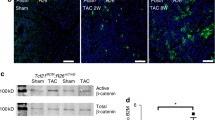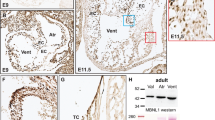Abstract
Distal outgrowth and fusion of the mesenchymalized AV endocardial cushions are essential morphogenetic events in AV valvuloseptal morphogenesis. BMP-2 myocardial conditional knockout (cKO) mice die early by embryonic day (ED) 10.5 [1], hampering investigation of the role of BMP-2 in AV valvuloseptal morphogenesis after this stage. In our previous study, we localized BMP-2 and type I BMP receptors, BMPR1A and Alk2, in AV endocardial cushions [2, 3]. Based on their expression patterns, we hypothesize that autocrine signaling by BMP-2 within mesenchymalized AV cushions plays a critical role during AV valvuloseptal morphogenesis. To test this hypothesis, we employed recently generated endocardial/endocardial cushion-specific cre-driver line Nfact1Cre. Unlike a previously generated Nfatc1enCre line whose cre-mediated recombination is restricted to AV and OT endocardium, this Nfatc1Cre line confers cre-mediated recombination within the endocardial cells as well as their mesenchymal progeny. Using the Nfactc1Cre driver line, we disrupted BMPR1A (Alk3) and BMP-2 specifically from AV endocardium and endocardial cushions. BMPR1A endocardial cushion cKO (cKOEndo) mouse embryos died by ED 12.5 and exhibited failure of cellularization of AV cushions (Fig. 22.1a–c) and disruption of extracellular matrix (ECM) protein deposition in the cushion mesenchyme. On the other hand, AV cushion formation occurred in the BMP-2 cKOEndo mice that survived beyond the AV cushion formation stage because BMP-2 expression remained intact in the AV myocardium during AV cushion formation. BMP-2 cKOEndo mice exhibited perimembranous ventricular septal defects (VSDs) (Fig. 22.1d, e), defective deposition of ECMs in the membranous septum, and AV mitral valve dysplasia, suggesting the cell autonomous requirement of BMP-2 in AV endocardial cushions. BMP-2 cKOEndo did not exhibit muscular VSDs. These data strongly support our hypothesis that cell autonomous signaling by BMP-2 in the endocardial lineage plays a significant role in mesenchymalized AV cushions during AV valvuloseptal morphogenesis.
You have full access to this open access chapter, Download chapter PDF
Similar content being viewed by others
Keywords
Distal outgrowth and fusion of the mesenchymalized AV endocardial cushions are essential morphogenetic events in AV valvuloseptal morphogenesis. BMP-2 myocardial conditional knockout (cKO) mice die by embryonic day (ED) 10.5 [1] at the initial stage for the formation of endocardial cushions, hampering investigation of the role of BMP-2 in AV valvuloseptal morphogenesis at the later stages. In our previous study, we localized BMP-2 and type I BMP receptors, BMPR1A and Alk2, in AV endocardial cushions [2, 3]. Based on their expression patterns, we hypothesize that autocrine signaling by BMP-2 within mesenchymalized AV cushions plays a critical role during AV valvuloseptal morphogenesis. To test this hypothesis, we employed recently generated endocardial/endocardial cushion-specific cre-driver line Nfact1Cre. Unlike a previously generated Nfatc1enCre line whose cre-mediated recombination is restricted to AV and OT endocardium, this Nfatc1Cre line confers cre-mediated recombination within the endocardial cells as well as their mesenchymal progeny. Using the Nfactc1Cre driver line, we disrupted BMPR1A (Alk3) and BMP-2 specifically from AV endocardium and endocardial cushions. BMPR1A endocardial cushion cKO (cKOEndo) mouse embryos died by ED 12.5 and exhibited failure of cellularization of AV cushions (Fig. 22.1a–c) and disruption of extracellular matrix (ECM) protein deposition in the cushion mesenchyme. On the other hand, AV cushion formation occurred in the BMP-2 cKOEndo mice that survived beyond the AV cushion formation stage because BMP-2 expression remained intact in the AV myocardium during AV cushion formation. BMP-2 cKOEndo mice exhibited perimembranous ventricular septal defects (VSDs) (Fig. 22.1d, e), defective deposition of ECMs in the membranous septum, and AV mitral valve dysplasia, suggesting the cell autonomous requirement of BMP-2 in AV endocardial cushions. BMP-2 cKOEndo did not exhibit muscular VSDs. These data strongly support our hypothesis that cell autonomous signaling by BMP-2 in the endocardial lineage plays a critical role in mesenchymalized AV cushions during AV valvuloseptal morphogenesis.
(a–c) BMPR1A cKO Endo mouse embryos exhibit failure of cellularization in AV cushions. Arrows indicate abundant mesenchymal cells in AV and outflow tract (OT) cushions in a control heart (A). Arrows show a few mesenchymal cells in AV and OT in a mutant heart (B). Arrowheads indicate abundant cells at the distal part of the mutant OT, which appear to be neural crest-derived and not reduced by BMPR1A endocardial/cushion-specific inactivation (C). (d, e) Endocardial/cushion-specific deletion of BMP-2 results in perimembranous septal defects (arrow in E), whereas control mouse heart shows well-formed ventricular septum (arrow in D). Ao aorta, IVS interventricular septum, TV tricuspid valves, MV mitral valves
References
Ma L, Lu MF, Schwartz RJ, Martin JF. Bmp2 is essential for cardiac cushion epithelial-mesenchymal transition and myocardial patterning. Development. 2005;132:5601–11.
Sugi Y, Yamamura H, Okagawa H, Markwald RR. Bone morphogenetic protein-2 can mediate myocardial regulation of atrioventricular cushion mesenchymal cell formation in mice. Dev Biol. 2004;269:505–18.
Inai K, Norris RA, Hoffman S, Markwald RR, Sugi Y. BMP-2 induces cell migration and periostin expression during atrioventricular valvulogenesis. Dev Biol. 2008;315:383–96.
Author information
Authors and Affiliations
Corresponding author
Editor information
Editors and Affiliations
Rights and permissions
Open Access This chapter is distributed under the terms of the Creative Commons Attribution-Noncommercial 2.5 License (http://creativecommons.org/licenses/by-nc/2.5/), which permits any noncommercial use, distribution, and reproduction in any medium, provided the original author(s) and source are credited. The images or other third party material in this chapter are included in the work's Creative Commons license, unless indicated otherwise in the credit line; if such material is not included in the work's Creative Commons license and the respective action is not permitted by statutory regulation, users will need to obtain permission from the license holder to duplicate, adapt or reproduce the material.
Copyright information
© 2016 The Author(s)
About this chapter
Cite this chapter
Sugi, Y., Zhou, B., Inai, K., Mishina, Y., Burnside, J.L. (2016). The Role of Cell Autonomous Signaling by BMP in Endocardial Cushion Cells in AV Valvuloseptal Morphogenesis. In: Nakanishi, T., Markwald, R., Baldwin, H., Keller, B., Srivastava, D., Yamagishi, H. (eds) Etiology and Morphogenesis of Congenital Heart Disease. Springer, Tokyo. https://doi.org/10.1007/978-4-431-54628-3_22
Download citation
DOI: https://doi.org/10.1007/978-4-431-54628-3_22
Published:
Publisher Name: Springer, Tokyo
Print ISBN: 978-4-431-54627-6
Online ISBN: 978-4-431-54628-3
eBook Packages: MedicineMedicine (R0)





